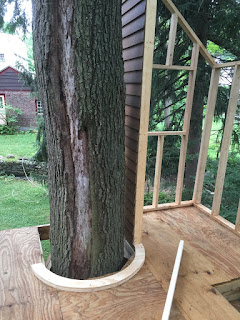 With thought to overall weight, I decided to use cedar bevel siding for the exterior, stained for a nice brownish natural cedar tone. I used stainless steel siding nails, which for the most part didn't split the siding. Part way through this process, I got a new hand rotary saw - a dremel saw, which was really easy to work with and significantly improved the time-consuming task of cutting siding panels to size, even adjusting cuts once the panels were up. I previously was using a more beefy rotary saw that required two hands to operate and was much more suited to cut 2x4's... Using the right tools for the job makes a huge difference!
With thought to overall weight, I decided to use cedar bevel siding for the exterior, stained for a nice brownish natural cedar tone. I used stainless steel siding nails, which for the most part didn't split the siding. Part way through this process, I got a new hand rotary saw - a dremel saw, which was really easy to work with and significantly improved the time-consuming task of cutting siding panels to size, even adjusting cuts once the panels were up. I previously was using a more beefy rotary saw that required two hands to operate and was much more suited to cut 2x4's... Using the right tools for the job makes a huge difference!
I wanted to stain the panels on the ground first and then put them up... but in the end, was racing against the weather, and so just cut them and nailed them up until an entire wall was finished, then stained in place. By the end, I was trying to stain in temps hovering around freezing which is not ideal - both for my hands and for the stain - which it says should be applied at temps above 50deg - oops... doesn't look too bad though...





















